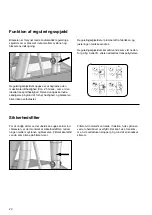
33
Pneumatic conveying
For the suction blower SupraVac 2000 Kongskilde’s
OK200 pipeline system must be used (diameter 200
mm). If pipes with another diameter are used, it will
reduce the conveying capacity considerably.
The conveying capacity of a suction blower is de-
pending on the set-up of the pipe system. Therefore,
carefully read the following instructions regarding the
set-up of the pipe system for the SupraVac 2000.
• Always use the OK200 dimension (diameter 200
mm) for the entire pipe system, if maximum convey-
ing capacity is requested.
• Keep the pipeline as short as possible. Do not use
more bends than necessary. This provides optimum
capacity and the most gentle conveying.
• Built up the pipe system, so that the suction head
should be moved at least as possible during the
work. This gives the easiest operation.
• Use only one polyurethane hose in the suction line.
The polyurethane hose is designed for clean up
only, and is used in order to get the highest pos-
sible flexibility. More polyurethane hoses will reduce
the conveying capacity considerably. For prolonged
operations of the blower use the heavy-duty flexible
steel hoses and pipes when possible.
• Pipes for suction side: Only use the heavy-duty
OKR200 pipes for the suction line. In order to get
the largest possible strength in the joints, the he-
avy-duty OKR clamps with bolt must be used.
• Pipes for pressure side: For the pressure line
OK200 pipes must be used. Use clamps with bolt to
assemble the pipes.
• Bends: Only use bends with a large rounding ra-
dius for the pipeline (radius 810 mm for 90 degree
bends, and 540 mm for 15/30/45/60 degree bends).
This gives the largest conveying output.
General principles for
installation and use of pipes
and bends
Distance between bends
There should be a minimum distance of 2 m between
any flow direction change, i.e. between any bends.
With larger suction blowers as SupraVac 2000 moving
higher capacities, longer distances are even better.
Installation of telescopes
Always ensure that telescopes are installed so that the
sharp edge points in the flow direction - not against. If
telescopes are installed in the wrong way, damage to
the material may occur.
Installation of bends
Do not put 2 bends back to back, as this will cause
damage to the material and there will be a loss of ca-
pacity.
It is recommended to use a heavier 1m pipe (OKR/
OKD) following each bend to compensate for wear.
Min. 2 m (6.6 ft)
Flow direction
OK pipe
OK Teleskop
Right
Wrong
Wrong
1 m (3.3 ft)
45°
45°
90°
















































